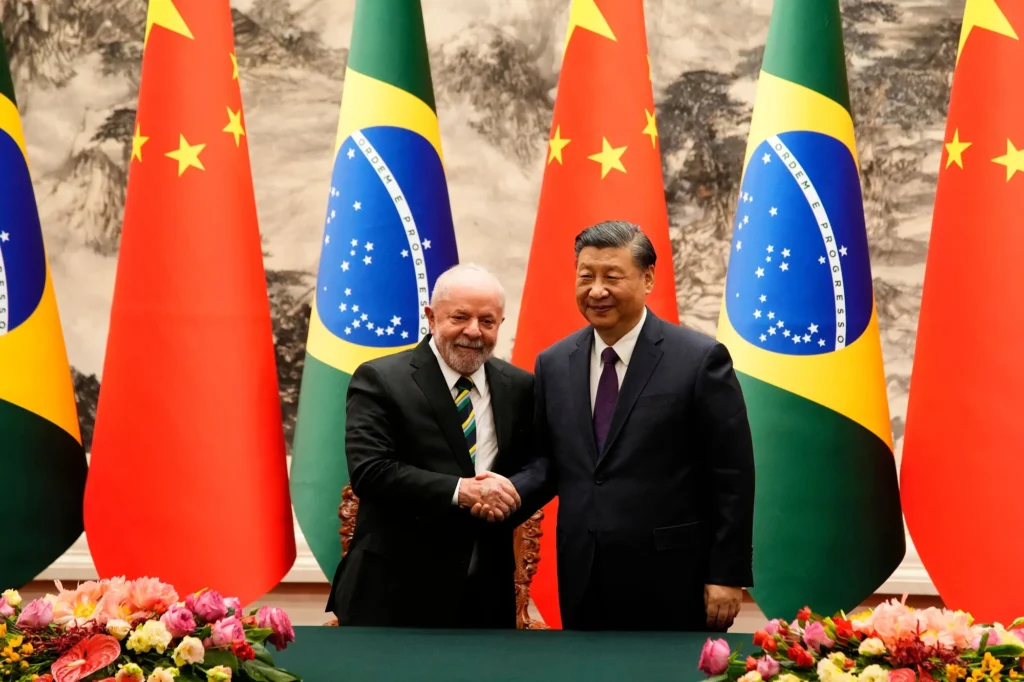Brazil’s President Luiz Inacio Lula da Silva, better known globally as Lula has launched a major initiative to meet the U.S. President Donald Trump’s unilateral tariff offensive by joining hands with Chinese President Xi Jinping and the Russian President Vladimir Putin, apart from taking assistance from South Africa and a few other left wing governments of Latin America.
Brazil is one of the main targets of Trump’s tariff attack in Latin America apart from Mexico. Brazil which will be hosting the BRICS summit in July 2025 is working on a plan to meet the offensive by Trump by talking to the countries affected by the Trump regime’s trade policies. President Lula will be meeting Russian President in Moscow in the second week of May this year in the course of his attendance at the Victory Day celebrations in Moscow. Brazil has cordial relations with Russia. Despite present bonhomie between Putin and Trump, Lula will try to identify some areas where the two countries can take a common stand against Trump’s policies.
Brazilian President will then be visiting t Beijing to participate in the China-Community of Latin American and Caribbean States (CELAC) Forum scheduled for May 12. Lula will have a bilateral meeting with the Chinese President Xi Jinping. This will be of special importance as this will be taking place after the meeting with President Putin. All three countries are founding members of BRICS. Lula is the president for the year 2025. So the comprehensive talks between three founding partners will be of help in preparing him for the agenda for the BRICS summit to be held on July n6 and 7 in Rio de Janeiro. The last BRICS summit was held at Kazan in Russia in October 2024.
It will be Lula’s first official trip to Moscow and his second to China during his third, non-consecutive term as president. During his previous administrations (2003-10), he visited Russia twice and China three times. China is Brazil’s top trading partner. In 2024, China accounted for 28 per cent of Brazil’s exports and supplied 24.2 of the country’s imports. The U.S. ranked second, providing 12 per cent of Brazil’s imports and purchasing 15.5 per cent of the exports as per the Brazilian official data.
Last Thursday, Lula said that he foresees no positive outcome from Trump raising tariffs on a wide range of products. “I am very concerned about the behaviour of the American government.
“I am concerned because free trade is being harmed and I am concerned because multilateralism is weakened,” he said. Brazil has already taken some retaliatory action against the U.S. regarding tariff hike but this has only been adhoc response. President Lula will be forming his studied response to the U.S. policy after assessing the April 2 announcement and its additional impact on the trade of Brazil.
Right now, the economic situation in Brazil is not comfortable. President Lula concluded his second year with contradicting economic results: high GDP growth and low unemployment combined with rising inflation, high interest rates, and a record devaluation of the Brazilian currency.
President Luiz Inacio Lula da Silva’s main goal in 2024 was to deliver a strong economic performance that could be translated into positive political results for his party and allies in the mid-term local elections. These elections were a crucial stepping stone towards his likely reelection campaign in 2026. But in midterm polls, the centre right and other anti- Workers Party members won putting in President in politically unstable position. The next presidential elections are due in 2026. So President Lula is determined to show results by implementing a policy which helps in creating enough jobs and bring down prices.
The paradox of Brazil’s economic situation is that while economic growth resulted in an all-time low unemployment rate, although nearly half of Brazil’s working-age population is out of the labour market. At the same time, persistent inflation forced the Central Bank to interrupt the benchmark interest rate (“SELIC”) reduction cycle and, later in 2024, to initiate monetary policy tightening, with the rate increasing 1.75 pp., from 10.50 percent to 12.25 percent—including a forward-looking statement with two additional 1 pp. hikes in early 2025 if economic conditions remain the same.
According to economic experts, the Lula administration’s fiscal policy strategy also created an unnecessary backlog in implementation of the economic policy agenda. Instead of having a credible and fully functional fiscal framework by the end of 2024, President Lula and Minister of Finance Fernando Haddad will likely have to pursue additional measures in 2025 in order to avoid a second fiscal policy crisis.
Moreover, implementation of the historic consumption tax system reform, approved in 2023, was delayed. Only one of the two implementing bills introduced by the Lula administration in 2024 was approved by Congress, and the introduction of other necessary bills was postponed to 2025.
Finally, the administration also pursued a number of policies throughout 2024 that point to increased government intervention in markets. Many of these policies are similar to Brazil’s first attempt at State capitalism since its return to democracy in 1985, and that eventually led to a recession that reduced the country’s GDP by 8.1 percent between 2014 and 2016.
President Lula’s popularity has declined as per the recent opinion polls, but the Brazilian president is rooted to the ground and he has amazing capacity for making a turnaround. His party leaders say that the President will make use of the next three months from April to June to pep up the country’s economy as also to improve the global image of Brazil through his interactions with world leaders and navigating successfully the BRICS summit in July this year. That way 2025 is a very critical year for the Brazilian president before the presidential polls in 2026. (IPA Service)

 JDU Requests BJP to Reconsider Retroactive Waqf Law
JDU Requests BJP to Reconsider Retroactive Waqf Law 